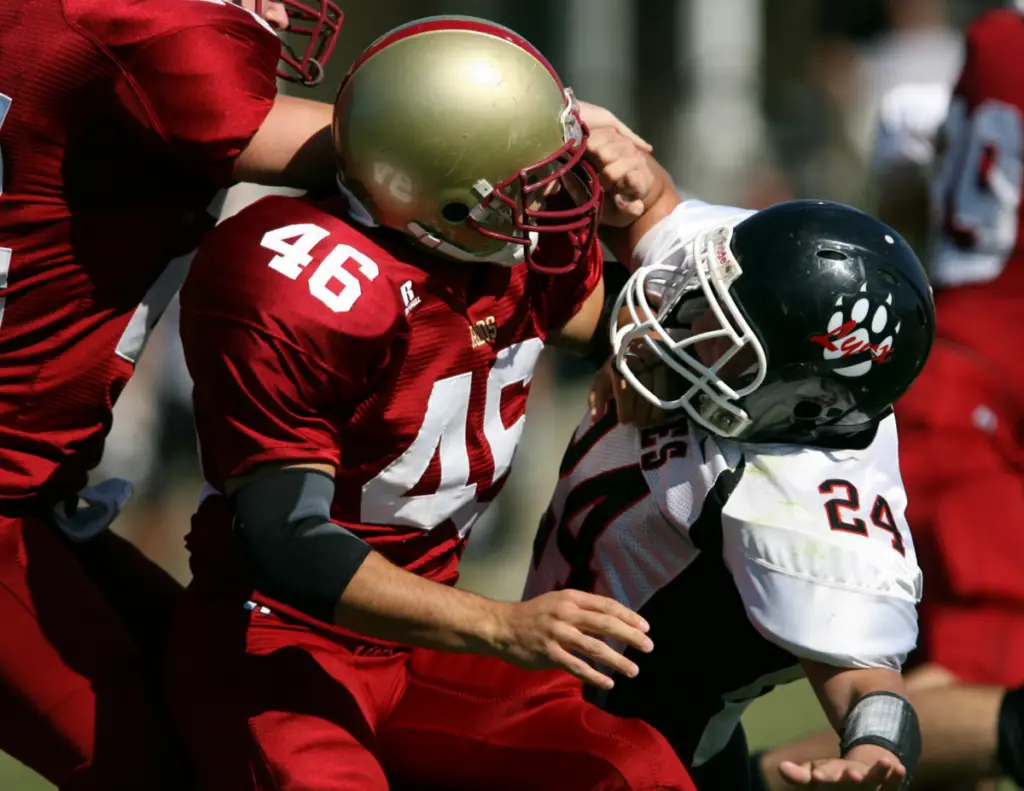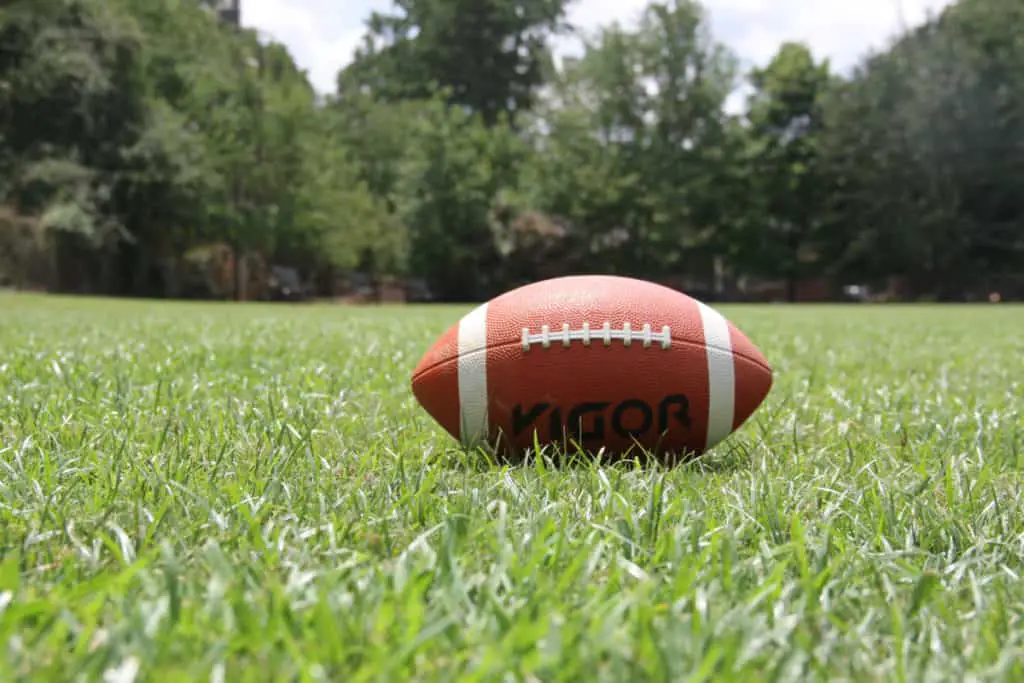Football is the most physical sport that one can play. Football is a full contact sport and protection and safety are a major concern. When the sport of football was invented, equipment looked much different, and so did the players who played it.
Football is a sport enjoyed by many, some as young as six years old. Even at the age of six, football can be a full contact sport. The technology as far as safety and comfort has come a long way, and helmets are a huge part of this.

Why Do Football Players Wear Helmets?
Football helmets are designed to minimize the risk of head injuries, such as concussions, and prevent injuries such as facial damage, bone fractures, and mouth injuries.
What is a Football Helmet Made Out of?
A football helmet is made out of molded polycarbonate. Polycarbonate is an extremely strong polymer designed to absorb big hits, but also withstand extreme temperatures.
This material is designed to absorb contact, but also be light enough for players to move quickly. The idea behind polycarbonate is to absorb the shock by spreading it out force so that other elements can take on the sometimes extreme force.
What is the Inside of a Football Helmet Made Out of?
The inside of helmets have advanced greatly over the years and continue to evolve quickly. The comfort level of helmets today is very high. Does comfort mean less safe? No.
The inside of helmets are made of a padded liner that is comfortable. This material is made out of polyurethane or nitrile foam. These materials are important for both comfort and for absorbing shock on impact.
This material is also designed to take on sweat and dirt and not have impact on safety and head on collisions. The material is known for being resistant to these issues.
Some helmets also include air pockets and extra shock absorbers, as the technology with helmets continues to improve and evolve.
These materials get tested at very high impacts, with safety in mind. These materials are designed to reduce the chances of head injuries, including concussions.
What is the Face Mask Made Out of?
The modern face mask now has a requirement of two bars. Years ago, there were no face masks. They then went to a one bar requirement. In today’s game, there are typically several bars on the face mask, providing extra protection.
Face masks are typically made out of titanium and then coated with polyarmor G17. This material is a thermoplastic powder coating that is designed to resist impact, abrasion, and corrosion.
Face masks are designed to protect the face, the mouth, and the eyes. Although fingers can sometimes cause some issues, face masks definitely reduce the opportunity for major issues.
Why do some Face Masks Look Different?
Depending on positions, face masks are designed slightly differently. Positions that are involved in a great deal of contact typically have extra bars and protection. Quarterbacks, running backs, and receivers will typically have less bars, which allows for optimal visibility.
Linebackers and linemen, who are involved in high impact will typically have full face protection, using multiple bars across the front of the helmet.
The Chin strap
The chinstrap is an important piece to the helmet and for safety. The chin strap is typically made out of foam. The foam part is the part that is resting against the chin. The out portion of the chin strap is made of plastic.
Chin straps do a decent job of resisting sweat and dirt, but sometimes these need to be replaced to keep them sanitary and fresh.
Securing the chin strap is an important part of using a football helmet. The chin strap should be pretty snug to the chin. This helps secure the helmet in place and avoid movement, which is not good to have on impact.
There are many different styles of chin straps, and many different designs as well. Choosing the proper fit and comfort level is important.
Will Helmets Prevent Concussions?
This is a topic that is highly debated amongst people in the football world. Concussions became known and popular several years ago, as many NFL players came out stating that concussions have impacted their lives beyond football.
Helmets are a valuable tool at reducing concussions, but do not totally prevent concussions. The technology today has improved the design of helmets and also the safety. It is important to understand that helmets do not totally remove concussions from being possible.
Companies are consistently reviewing how effective helmets are and the impact they have on head injuries.
How to Properly Fit a Football Helmet
Fitting a helmet properly is extremely important for safety. The best way to fit a helmet is by using the following steps:
- Place the hemet on the player’s head
- Make sure that the chin strap is secure and snug
- Have the player look straight ahead
- Grab the facemask and attempt to move left and right
- If there is wiggle room, the helmet does not fit properly
- If there is no wiggle room, the helmet is a good fit
What Else can be Done to Help Fit a Helmet?
Helmets have a liner with air. Air can be placed into the helmet to make sure that it fits snug to a player’s head. If the helmet is too tight, air may be removed to gain a better fit.
Over the course of a season, air can be released through contact. It is important to check the status of the helmets on a regular basis. The helmet should fit securely, but not leave marks on a player’s forehead.
Proper Tackling
Helmets are a piece of equipment, but players should not tackle by leading with their head. Proper tackling techniques need to be taught. Proper tackling techniques will help reduce the possibility of injury.
The helmet should never be an excuse to tackle with, as leading with the head is both illegal and dangerous. Keeping the head out of a tackle is imperative when coaching football at any level.

Final Thoughts
Football players wear helmets to keep them safe. Helmets are expensive pieces of equipment that can mean the difference between a head injury or not.
It is important to fit the helmet properly as to reduce possible issues. Each player will fit differently, so each situation is unique.
Technology continues to improve as companies are working hard to make sure that players are safe during football activities.
The helmet is extremely important. Although the helmet will not completely prevent head injuries, it is a great way to reduce injuries.
